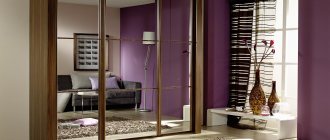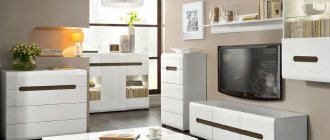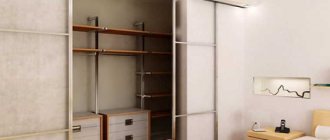Is it possible to build a regular refrigerator into a closet?
If a situation arises when the refrigeration unit cannot fit into the overall design of the kitchen, a special place (cabinet) will come to the rescue where it can be placed so that it does not “disturb” the eye. In our discussion, there are two types of refrigerators:
- intended for embedding;
- those that were not originally intended for these purposes.
On a note! A regular refrigerator can also be built into a closet.
For both options, you just need to take into account some aspects, which will be discussed below.
Safety regulations:
- The back wall of the cabinet should not be pressed tightly against the heated elements of the refrigerator. The heat generated can start to interact negatively with paint or objects that are stuck between the walls. Such interaction is fraught with fire or damage to the technical characteristics of the cabinet.
- If possible, it is better to remove the legs of the refrigerator or discard the bottom of the drawer. Refrigerators that are designed to be built-in may have legs, but they may not be used. In conventional cold storage units, the legs are usually non-removable, which increases the specific gravity pressure on the bottom of the cabinet. The correct location of these household appliances is the key to successful operation.
- The internal volume of the box should not be exposed to heat from a stove or other elements. Please note that gas stoves can heat the refrigerator, even despite the cabinet partition. Place these appliances at an appropriate distance from each other, as in a normal arrangement.
Operating rules:
- Check the back wall regularly for cobwebs and debris. Blockages can not only cause a fire, but also cause impaired thermoregulation, and as a result, failure of the cooling properties of the freezing compressor.
- Try not to put anything on top of the cabinet. This surface is not a place for things or treasures: firstly, they can damage the overall structure, and secondly, they increase the level of fire hazard.
- Avoid sudden impacts or physical impacts that could dislodge the household cooling unit from its installation location. This rule applies to all household appliances without exception, even taking into account their special placement locations.
Advice! Never leave decorative magnets on refrigerator doors. Magnets can harm the operation of sensitive climate equipment inside the refrigerator (electronic thermometers that are installed in the door, etc.), and also look simply unsophisticated.
You can get rid of the tape or magnets and then use double-sided tape to place them on the cabinet door.
RESULTS ¾Ð»Ð¾Ð´Ð¸Ð»Ñника
RESULTS ROOM, ROOM, ROOM, ROOM °Ð¹Ð½ инÑеÑÑеÑа Ñвоей кÑÑни.
ROOM RESEARCH RESULTS SS.
RESULTS ss RESULTS на кÑÑне гаÑмониÑнÑй инÑеÑÑеÑ.
RESULTS
- RESULTS RESULTS ÑеплоизолÑÑÐ¸Ñ ÑÐ²Ð¾Ð¸Ñ ÑÑен;
- RESULTS › RESULTS;
- RESULTS, RESPONSIBILITY еÑÑво – Ð¸Ñ Â“Ð½ÐµÐ·Ð°Ð¼ÐµÑноÑÑÑ”.
RESULTS ¹
Possible ideas: how to hide a refrigerator in a kitchen cabinet
The main idea is to choose a drawer that does not look flashy and distinctive from the design of your kitchen.
The protruding handle for opening immediately catches the eye and gives away the “secret” that there is something behind the door. It is recommended to use special invisible handles. They are almost invisible and practical to use, which will add more technology to your kitchen.
If you have enough space, you can use soundproofing materials (they take up more space) to line the cabinetry, which will significantly reduce the overall noise level.
You can install special lighting with a battery inside the drawer, which will allow you to comfortably take food from the refrigerator, even if you have problems with the power supply (the light has gone out).
What do you need to build a refrigerator into a closet?
Access to power grid. The first thing you need is to solve the problem with wiring and free access to the outlet in advance. Buy an extension cord with a spare wire, which will allow you to make rearrangements in the future.
Physical strength to carry out the installation process. It is better to share this task with a partner (or even with more workers). It is better to defrost the refrigerator first, which will reduce its overall weight. It is better to lift heavy household appliances using jacks.
Alternative places to install the refrigerator if it does not fit in the kitchen
Most often, you have to resort to alternative solutions when there is very little space in the kitchen, and you don’t want to give up any pieces of furniture or appliances. In this situation, you can consider placing the refrigerator outside the kitchen walls. The big advantage of this solution is saving space, but on the other hand, using the refrigerator is no longer so convenient, because every time you have to leave the room and go to another place to buy groceries.
The refrigerator should be located in an accessible and convenient place.
Refrigerator installed in the hallway
In small apartments it happens that there is no room for even a small refrigerator in the kitchen. Most often, the closest space is the corridor. This is where the refrigerator is often installed if there is not enough space in the kitchen. If the refrigerator was originally located in the kitchen, and there was a need to move it into the hallway, then first you need to remove the door so that it does not interfere with the transfer process.
Most apartments have small kitchens, so in order not to clutter up a lot of space, the device should be chosen in small sizes.
In some homes, the size of the kitchen simply does not allow installing even a small refrigerator in it. In this case, it is taken to the nearest room - most often to the corridor. If there is a connecting door between the living room and kitchen, you can install it in the next room.
It is only important to remember that the refrigerator should not stand close to the wall; it is important to leave some free space so as not to disturb the air exchange processes. Additional information: This arrangement is rather a necessary measure, when there are absolutely no options left, and is suitable as a last resort
This is due to the fact that it is completely inconvenient to go to the corridor for groceries every time
Additional information: This arrangement is rather a necessary measure, when there are absolutely no options left, and is suitable as a last resort. This is due to the fact that it is completely inconvenient to go to the corridor for groceries every time.
Is it possible to move a bulky unit onto the balcony?
Moving the refrigerator onto the balcony is not possible in every case. The fact is that the refrigerator does not tolerate both heat and cold in the space very well, this directly affects its performance characteristics. Most often, only residents of the south of the country can bring such a unit onto the balcony, because it is practically impossible to find cold weather there. But you should also be afraid of overheating.
If the temperature outside is above 30 degrees, then the refrigerator located on the balcony will quickly fail.
However, there are models of a special climate class - they are not afraid of the cold. The same can be said about refrigerators equipped with a no frost system.
But even in the case of such models, it is important that the balcony is insulated and protected from moisture using a ventilation system. Equipment must also be hidden from sunlight
How to hide a refrigerator in a closet with your own hands
During the installation process, it is better to protect the floor covering with a hard cloth, which will protect your floors from scratches and other mechanical damage.
Use construction straps to accurately position the cooling unit housing. With their help, you can install it at the planned location.
For greater comfort during installation, you can remove the cabinet door, which will allow you not to worry about the possibility of causing mechanical damage to it, and then simply screw it into place.
Is it possible to build a regular refrigerator into a kitchen cabinet?
Placing large appliances in special kitchen cabinets or modules allows you to disguise them behind beautiful facades. Of course, today there are built-in factory models, but they do not belong to the category of budget options. The difference in price of such units is due to design features, as well as improved thermal insulation and fire safety.
Can a regular refrigerator be built-in? Yes, for free-standing models it is quite possible. It is important to adhere to a few basic rules: having free access of air for thermoregulation and avoiding overheating, as well as designing a well-thought-out door opening system. It is also important that any configuration change will not allow repair of household appliances under warranty. Therefore, there is a certain risk of high unexpected costs during the maintenance process.
Refrigerator location
Due to the limited number of places where you can put a refrigerator, sometimes a situation arises that it is difficult to place it in the kitchen or room. Therefore, it is often necessary to install the unit in the corridor, and this brings with it both positive and negative aspects.
Pros:
- freeing up space in the kitchen or room;
- unusual design solutions and the opportunity to apply more creative ideas that would not fit into the style of the kitchen;
- less contamination of the refrigerator due to the fact that food is prepared away from the device, and there will be fewer stains on it;
- no need to carry purchased groceries to the kitchen or room, because everything can be laid out at the entrance to the apartment.
Minuses:
- the process of cleaning the device will be more difficult, because you will have to go to the kitchen or bathroom to get water and the necessary cleaning products;
- cooking may become less convenient, because you will have to first transfer all the products from the refrigerator to the kitchen or you will need to go for them several times;
- a clutter of things and equipment in the hallway, which significantly reduces free space.
Despite all the shortcomings, a creative approach can turn an unusual solution for placing equipment in the hallway into something original.
Pros and cons of building in a conventional refrigerator
Making a refrigerator cabinet with your own hands has certain advantages:
- obtaining an individual room design;
- harmonious combination of household appliances with other interior items;
- the cost of a free-standing refrigerator is an order of magnitude lower than a factory built-in model, even if the module is manufactured independently.
The option of installing a refrigerator yourself has certain disadvantages:
- noticeable overheating of the working part;
- faster failure of a household appliance.
To prevent excessive heating, the cabinet is equipped with special ventilation holes. In some cases, overheating can be avoided by removing the bottom and rear wall of the module, which can negatively affect the level of stability of the structure.
Among other things, all models of free-standing refrigerators are distinguished by fairly substantial dimensions, have impressive depth and width parameters, so the built-in design is most often massive and rather bulky. Such a cabinet cannot always be installed in small-sized kitchens or rooms with a non-standard layout.
What to consider when choosing refrigerator sizes
- Dimensions of the kitchen space.
The refrigerator is most often located in the kitchen. And most of us have small kitchens, since a significant part of Russians live in “Khrushchev” apartments, which have very compact and inconvenient room sizes; - Family size.
It is logical that a large family requires a lot of products. If a person lives alone and does not plan to change the number of eaters in the house in the near future, then his large refrigerator constantly runs the risk of remaining half empty. Not to mention the large-scale two-door variants.
Studying photos of various kitchen interiors, you can see among many of them options without a refrigerator. It's really just a little trick. After all, no housewife can do without this device, but some prefer to hide it in a kitchen cabinet. Such built-in models have become especially popular recently. Therefore, more and more manufacturers are offering them to their customers.
Initially, only washing machines and dishwashers were built-in, but their unprecedented popularity among housewives prompted modern manufacturers to create similar refrigerators. These devices have several features
.
- First of all, it is a universal design
. Conventional refrigerators tend to be light in color. It can be milky, beige, white, silver, etc. Naturally, it will stand out greatly among the kitchen interior. A refrigerator in any color will disrupt the overall harmony and will differ from all the cabinets installed in the kitchen from the same set. If it turns out to be built-in, then the owner of the light appliances will be able to avoid imperfections and make their kitchen truly cozy, beautiful and modern. - Some users decide to cheat and install a regular refrigerator in one of the cabinets. But this is a bad idea, since in this case the service life of the device in question will be significantly reduced. In such conditions, the refrigerator will not be able to function fully. Built-in models are created in a special way
and feel great even in a closet or special box. This arrangement does not in any way affect the life and functionality of the device. - The dimensions of a built-in refrigerator are usually smaller than usual. But its special internal arrangement allows you to fit all the necessary products.
- Modern built-in models can be installed not only at home or in an apartment, but also in office premises and even in a car. The latter option is especially convenient, for example, for long trips.
- You can even create a cabinet or box for a built-in refrigerator with your own hands. This will allow you to make exactly the model that is ideal in design, size, and all other characteristics for a particular kitchen.
Principles of installation and operation of built-in equipment
It is advisable to design the cabinet frame before choosing a kitchen unit, taking into account the overall style of the room and the characteristics used in finishing materials. In this case, you should also remember the following nuances of manufacturing the structure:
- overall width indicators - width of the refrigerator + thickness of the side parts and hinge allowance;
- overall height parameters - refrigerator height + small margin for ventilation;
- side walls - refrigerator depth + allowance 50–70 mm;
- shelf - module width minus the thickness of the side walls;
- the back of the shelf - indicators of the width of the inner part of the box + the thickness of the upper part with the shelf, which is installed above the cooling apparatus;
- spacers - the length corresponds to the width of the module and the dimensions of the frame base.
The base part of the cabinet involves installing the upper part of the strip at a standard height of 10 mm from the floor surface, and to mark the facade, 0.2 cm should be added to the width and height of the pencil case, taking into account the possibility of subsidence.
To install a refrigerator you will need to prepare:
- lumber for making bases and chipboards;
- door hinges with closers and a wide opening angle;
- door handles;
- fasteners;
- paint and varnish material;
- self-adhesive film;
- construction tape and marker;
- jigsaw with wood blades;
- drill and screwdriver;
- small hammer.
In accordance with the prepared project, parts are marked that should be carefully cut out using an electric jigsaw. If necessary, all edges are processed.
For complete cooling, the cabinet must have no back part, however, it is advisable to make several spacers to secure the structure
There should not be a hob or oven next to the refrigerator cabinet.
Technology for assembling the frame and embedding the refrigerator:
- Fixing the upper part of the cabinet and the shelf installed above the unit to the racks using small fixings.
- Screwing the rear wall of the module with screws to the end of the shelf.
- Fastening the rear wall to the racks using corners.
- Installation at the rear of the module with a wide spacer.
- Fixing the small spacer with metal corners.
- Placing the finished frame base of the cabinet in the selected location, followed by leveling the entire structure using a building level.
- Fastening the module to adjacent kitchen furniture items.
- Connecting the cabinet to the wall using metal corners.
- Installation of spacers at the level of the base part with fixation with corners.
- Screwing door hinges onto the side post.
- Drilling a hole to lead out the cable connecting to the electrical network.
- Installation of a household appliance. The handle is removed from the unit, after which it is placed inside the furniture module and attached to the side racks. This ensures the required level of structural stability.
The built-in refrigerator should be easy to open and close using the cabinet door - Fixing the front part to the refrigerator door using corners.
Fixing the cabinet fronts to the refrigerator doors can also be done using a pair of ball guides
Only after a complete check of the functionality and strength of the manufactured module is the household appliance connected to the electrical network.
Independently integrating refrigerators into kitchen furniture has advantages and disadvantages. Having assessed their relationship, one can come to the logical conclusion that such an arrangement is quite acceptable. But such work is not always advisable.
Principles of correct placement
To ensure that the refrigerator blends harmoniously with the decor of the room, it is worth considering the principles of proper placement of equipment.
Convenient places to install the refrigerator - in the corner or near the door/at the entrance to the kitchen
Refrigerators in the corner help save space. In addition, equipment with impressive dimensions will not look too bulky there.
The device, placed near the door, allows you to quickly arrange products brought from the store, and also divides the space into two separate zones, acting as a partition. In this case, the device can be placed in a plasterboard niche or the door can be dismantled, visually expanding the space.
The most inconvenient options for placing a refrigerator are...
- in close proximity to the stove or too far from the sink;
- in line with the kitchen sink and stove;
- at a considerable distance from the table and doorway;
- at the bar, kitchen island or table where the family eats.
Sometimes a refrigerator can fit into a niche formed by moving a doorway
With such a redevelopment, the old doorway is blocked, and a new entrance is made in the partition separating the kitchen from the living room. This technique works well in Khrushchev and a number of other types of houses with small kitchens.
If the kitchen is very small, then the refrigerator can be moved to an adjacent room or corridor
In some apartments, the kitchen takes up a very small area, so the refrigerator has to be sacrificed. The device can be placed in the living room or hallway. For convenience, it is recommended to remove the door leading to the kitchen and place a table near the refrigerator for unloading food.
For a small kitchen you should choose compact models
The optimal choice would be a narrow (40 - 55 cm) but tall (about two meters) device or a mini-unit that can be placed under the countertop. A regular device with a volume of up to 120 liters is also suitable.
It is preferable to place the refrigerator closer to the sink rather than to the stove
Placing the unit near the sink will save time and effort, because we usually perform actions in the following sequence:
- take food out of the refrigerator;
- placing food on the kitchen counter to unpack and cut;
- we go to the sink to wash our hands, food or dishes;
- We cook food on the stove.
Between the refrigerator and the sink, it would be wise to place an area suitable for unloading bags of food and preparing food for adding to a dish.
If possible, the refrigerator should be built into the unit
Household appliances built into the kitchen set save space and unite all kitchen surfaces. Thanks to this, the space visually expands and the interior seems more stylish.
In addition, if the unit is built-in, it will be easier to keep it clean - just wipe the facade and the inside of the chambers, while a free-standing refrigerator requires regular cleaning of the top, the space behind the back wall and around the walls.
Create a harmonious interior design
For the interior to be harmonious, the design of the refrigerator must be combined with other elements: curtains, furniture, apron, etc. Original appliances look better in a restrainedly decorated room.
You can create a storage area above a free-standing refrigerator
This could be a basket, a box for storing various small items, or a shelf. It is convenient to place a microwave oven on a low device.
The depth of the refrigerator must correspond to the depth of the cabinet
In this case, the unit will not disrupt the straight line of the kitchen furniture set, and the interior will remain harmonious
This rule is especially important for small rooms in which you plan to install a free-standing refrigerator
Sometimes the refrigerator can play the role of the main accent in the interior
SMEG focuses attention on itself
For example, you can opt for SMEG equipment, which is not only practical, but also original in appearance
You can even focus on a regular unit. To do this, you need to design its body in one of the following ways:
- thermal film with photo printing, fixed using hot air from a hair dryer;
- Magnetic vinyl;
- vinyl stickers;
- decoupage;
- paint matching the color of the set;
- painting with acrylic paints on a sanded and primed surface.
Advantages of installing a refrigerator
- Unique kitchen style . When doing it yourself, you have the opportunity to take into account all the nuances that relate to shape and size and come up with your own unique design.
- Saving money . The cost of a refrigerator that is built into the kitchen with your own hands is much lower than a factory built-in model.
- Combination with kitchen furniture.
- Noiselessness – the equipment is located in a closet, therefore, the walls of the furniture help block noise.
- A separately purchased refrigeration unit, as a rule, has a larger volume and capacity .
Embedding Features
It should be remembered that any household appliance that runs on electricity needs free access to air. Otherwise it will overheat. Compactness is the main reason for the demand for embedded technology. Particular attention should be paid to the location of the refrigerator in the box. It is important to adhere to several basic rules:
- It is recommended to remove the bottom and back wall of the cabinet from the cabinet or drill holes in them. This will allow air to circulate freely.
- For normal operation, it is necessary that the distance between the walls of the refrigerator and the cabinet be at least 2-3 cm.
- Opening the doors of the cabinet and then the refrigerator is not very convenient, so it is recommended to use a special hinge mechanism.
General principles for installing a built-in refrigerator
There are two types of built-in refrigerators - fully built-in and partially built-in. When fully built-in, the device is located entirely in the cabinet, with a front door attached to it. During partial installation, there is no need to hang the door - the refrigerator itself is already equipped with an aesthetic and functional front panel.
When installing equipment, you need to adhere to the following principles:
- strictly follow the instructions supplied with the refrigerator;
- choose or design a cabinet with indentations on all sides of the device of at least 2-3 cm for ventilation;
- make sure there are ventilation holes at the bottom and on the back wall of the cabinet;
- follow the rules for the location of the refrigerator in the kitchen;
- Make sure there are no slopes - the refrigerator should stand level.
It is important to remember: you cannot install the refrigerator next to radiators and heaters. The location should be such that the door can easily open to at least 110 degrees for ease of use.
Choosing a mounting method
The installation is carried out using two mechanisms:
- guides;
- hinges
The guides are attached to the facade and door of the refrigerator, thereby synchronizing the opening. The method ensures structural strength, but due to its complexity it can break more often, and the opening angle is usually small.
Hinges are attached to the refrigerator door, and the facade is hung on them. This makes opening as simple as possible, and the design is reliable. The disadvantage is the need to accurately calculate the weight, exceeding it is dangerous due to breakage, and the cost of such hinges.
TIP: it is better to purchase a built-in refrigerator with a suitable set - this will eliminate compatibility problems. An alternative is to individually order furniture for built-in appliances from professionals who will take into account all the nuances.
It is recommended to make kitchen furniture yourself only if you are confident in your abilities or have sufficient experience, since installation errors often lead to damage to the equipment, and this voids the warranty.
General procedure
The algorithm by which refrigerators are built depends on the specific model. In general it looks like this:
- the unit is unpacked, transport fasteners and films are removed;
- the device is inspected and tested for functionality;
- if necessary, change the location of the cabinet door hinges;
- the device is inserted into the cabinet, but not all the way - about 10 cm is left for ease of fastening the facade;
- the evenness of the device, the position and strength of the hinges, brackets, legs are checked, and if necessary, the bolts responsible for the level are adjusted;
- after installing all the fasteners, the refrigerator is completely pushed into the cabinet;
- all mechanisms and gaps are covered with plastic linings, often included in the kit, and decorative panels;
- door opening is checked;
- The operation of the refrigerator in the installed state is checked again.
If you purchase a semi-built-in device, the complexity of the work is halved. It is enough just to install it in the closet, secure it with corners or bolts, as required by the instructions, and cover the gaps with decorative panels, not forgetting about ventilation.
Can also be installed in a wall cabinet. The main thing is to strengthen the fastening. This is done by vertical metal rods, horizontal guides and the use of additional sheets of material from which the cabinet is made.
Assembling the cabinet for installation
You should take care in advance to prepare for installing the refrigerator. Prepare all the necessary materials and tools for work.
Sometimes, when planning a kitchen set, you realize that the refrigerator does not quite fit into the interior of the kitchen, and the budget does not allow you to purchase a built-in one. The solution to this problem will be the ability to build it into the kitchen yourself.
To build in a regular refrigerator, you need to make a box into which the refrigerator is then built. You can use the services of professionals or make a cabinet yourself, because this way you can save a lot.
Before you start making or purchasing anything, you need to decide on the size. It’s best, of course, if you plan to build a box for the refrigerator at the kitchen design stage. This way you don’t have to look for a material that will match the color of your existing kitchen set. You also need to immediately select the place where the refrigerator will be located and take measurements for the cabinet. It is important to remember when taking measurements: to cool the refrigerator, air must always circulate around it, so the cabinet must be larger.
Measuring parts must be approached with special care. Below we will look in detail at how to correctly calculate the dimensions for a cabinet. The first step is to measure the depth, width and height of the device. In addition, we will need the distance from the floor to the gap between the refrigerator doors. Determining the dimensions of the box itself is a little more difficult.
First, let's decide on the external width of the furniture. For hinges, you must leave at least 30 mm. If we assume that the width of the refrigerator is 500 mm, and the width of the side walls of the box is, say, 15 mm, then the external width will be at least 560 mm.
The height of the pencil case can be any, the main thing is that the refrigerator fits. Ideally, it should be equal to the height of the rest of the kitchen unit. It will look beautiful, and besides, there will be space on top for shelves.
The side walls of the cabinet should be at least 50 mm longer than the depth of the refrigerator. This is necessary for installing hinges and future cabinet doors. Let’s say if the depth of the refrigerator is 500 mm, then the side walls should be 500 + 50 = 550 mm.
The shelf above the refrigerator is calculated using a simple formula - the total thickness of the side walls (15 mm) is subtracted from the external width of the cabinet (in our case 560 mm). For our situation it will be 560 – 15 * 2 = 530 mm. It is worth considering that the shelf should not reach the back wall of the cabinet, because it is necessary to leave a gap for ventilation. Otherwise, the refrigerator will overheat. You need to leave about 100 mm, and it turns out 550 – 100 = 450 mm.
The rear wall of the shelf is equal in width to the shelf itself, that is, in our case it is 530 mm. The height of the wall depends on the height of the niche, and, in principle, you can make it any height, most importantly, do not forget to take into account the thickness of the top cover and the panel above the refrigerator.
The top panel of the box is needed if you plan to build a cabinet above the refrigerator for storage. You can completely close the top, but in this case you will have to make a hole there for air circulation. Or you can leave a space of 100 mm to the wall.
Also, don't forget about the spacers. Their width should be 140-160 mm, and their length should be equal to the internal width of the cabinet.
The base should be slightly less than the distance from the floor to the bottom door of the refrigerator. For example, if the distance between them is 60 mm, then the height of the base should be approximately 45-48 mm. The length of the base and the width of the cabinet must be the same.
Among the advantages of making a pencil case without the help of specialists, we can note its uniqueness and the ability to adjust the dimensions to those that you need.
Among the disadvantages, it should be noted that such a device will most likely lack the flow of cold air, and considering that the cabinet itself is made of flammable objects, this also does not entirely meet safety regulations.
Alternatively, you can pull out the bottom and back wall, but in this case the cabinet will lose its stability, which can lead to bad consequences. You can screw the cabinet to the wall, but then, again, the air circulation will worsen.
Also, the refrigerator itself has large dimensions, and the cabinet will be even larger, so it will seem bulky, and the cabinet doors will take up a lot of valuable space when opened.
Models
The assortment in household appliance stores is huge. To better navigate this diversity, here are a few examples of built-in refrigerators in different price categories.
Atlant XM 4307-000
One of the most popular and inexpensive models of Belarusian production. Two-chamber refrigerator (two doors: refrigerator and freezer), useful area 234 liters. Its height is 178 cm, width – 54. Inside the refrigerator compartment everything is quite simple: 3 glass shelves, a compartment for vegetables/fruits, 4 plastic shelves on the door. Defrosts automatically (drip system).
The freezer has 3 plastic drawers inside and is defrosted manually.
The refrigerator is controlled mechanically. No additional devices or bells and whistles: an egg stand, ice trays - that's the whole set.
For safety, it can stay cold for 16 hours if there is a power outage. The manufacturer provides a 3-year warranty.
According to reviews, this is one of the most acceptable options in its price category. It operates very quietly, which is perfect for a kitchen-living room. There is a positive experience of integrating it into Ikea furniture. One of the disadvantages that all buyers note is that in order to defrost it, you need to unplug it from the outlet. For built-in technology this is a significant drawback.
According to reviews, this is one of the most acceptable options in its price category. It operates very quietly, which is perfect for a kitchen-living room. There is a positive experience of integrating it into Ikea furniture. One of the disadvantages that all buyers note is that in order to defrost it, you need to unplug it from the outlet. For built-in technology this is a significant drawback.
Beko CBI 7771
Two-chamber refrigerator, country of origin – Türkiye. In terms of usable area, it is slightly larger than the previous one: 242 liters. Has an antibacterial coating. The refrigerator compartment is equipped with three glass shelves and a “freshness zone”. Defrosted using a drip system. The freezer with three shelves is equipped with a No Frost system. Height 177 cm. Mechanically controlled. 13 hours of autonomous cold maintenance.
According to customer reviews, this model is quite reliable, but not very spacious - it’s difficult to fit a week’s worth of groceries. Another disadvantage is the lack of an area for storing fruits and vegetables. No Frost in the freezer speaks in favor of the model.
Hotpoint Ariston BTSZ 1632/HA
Model built under the countertop. The height of this refrigerator is 81.5 cm. It has a small freezer hidden under the same door with the refrigerator compartment. The useful volume of the unit is 98 liters. Inside there is a glass shelf and a compartment for fruits and vegetables. On the door there is a shelf for bottles and a top lockable shelf with an egg holder. Both chambers are defrosted manually.
Siemens KI39FP60RU
An expensive model from a German manufacturer, consisting of two cameras. The refrigerator has a drip defrosting system, the freezer has “No Frost”. Inside the refrigerator there are three shelves, a freshness zone, and an area for vegetables and fruits.
The developers have added many bells and whistles to this model: antibacterial coating, LED lighting inside, electronic display for control. The refrigerator also has several “smart” modes: super-freezing, super-cooling and “holiday” (when the temperature in the empty refrigerator is maintained at 12°C so that mold does not form in it with minimal energy consumption). If someone forgets to close the door, the alarm will “remind” them of this. In addition to standard egg stands and ice trays, the kit also includes cold accumulators that can be inserted into a cooler bag or a regular grocery bag.
How to install a refrigerator in a closet
The correct arrangement of furniture and household appliances in the kitchen determines not only the overall appearance of the room, but also helps to rationally use the usable space. This is especially true for small apartments. Residents often wonder how to build a refrigerator into a cabinet if the square footage is very limited or the unit does not require its placement in a niche. Optimally, purchase a built-in model. But if this option is not suitable or you have already purchased a regular refrigerator, then you can find a lot of solutions for creating a harmonious interior without installing special equipment.
Location in the kitchen interior
In accordance with the design decision, the refrigerator can be completely built into the kitchen unit, dissolving at the same time into the interior. In another option, it can be only partially hidden, being “recessed” into a niche between cabinets, or in the corner part of the kitchen, separated by a partition.
In the first case, decorative facades are installed on the refrigerator doors, completely matching the design of the kitchen furniture. Typically, such panels are made to order, taking into account all the features of the refrigerator, which may be multi-chamber and will require a particularly precise fit to the dimensions.
A much simpler option would be to install a refrigeration cabinet in a kitchen unit cabinet that is suitable in size. This can usually be done with a single-compartment refrigerator that does not have a freezer compartment.
Three types of door designs are possible when installing a built-in refrigerator:
- The refrigerator itself is built into the cabinet body, but its door protrudes about 5 cm and does not have any decorative trims;
- The protruding door is lined with decorative panels, but retains the original handles and the lines of the metallized surface of the refrigerator are visible along the contours;
- A fully integrated refrigerator, the door of which completely merges with the surface of adjacent cabinets.
In this case, the question does not arise whether it is possible to place an oven next to it, since a furniture wall with a frame will serve as a delimiter and protect both appliances from affecting each other.
When installing a small refrigerator, for example, in a taller kitchen cabinet, you can arrange it next to a microwave mounted on top, hiding both household appliances.
Is it possible to build a regular refrigerator into a closet?
There are two types of units on the refrigeration equipment market:
- Built into a furniture set.
- Freestanding models.
Both refrigerators perform one function - storing perishable foods. But there is a huge difference between devices. It lies, first of all, in design features: in built-in refrigerators, the role of the door is performed by decorative panels or facades. This feature, coupled with a set of additional options and the popularity of the brand, leads to a significant increase in the price of a household appliance. For those who have a limited budget or the type of design is not important, free-standing models are an excellent alternative.
Regardless of what you choose, it is important to take into account a number of technical nuances associated with using the refrigerator.
Safety regulations:
- There must be sufficient distance between the rear wall of the cabinet and the heating elements of the device. Ignoring the requirement can lead to negative consequences, including ignition of the entire column and damage to equipment.
- When installing a conventional refrigerator, the legs of the unit should be used as supporting elements of the furniture module. The housing for this type of device must have no bottom. In built-in types, the supports are usually removable, which avoids additional pressure on the lower part of the furniture structure.
- Refrigeration equipment must be located away from heating appliances. Thermal effects from the oven and hob do not have the best effect on the operation of the unit. It is worth understanding that the body of a furniture cabinet does not serve as protection against generated heat.
Operating rules:
- Regular inspection of the rear wall of the equipment is the key to longevity in operation. Uncleaned cobwebs, dust, and dirt on the condenser can lead to disruption of thermoregulation, resulting in machine failure and even fire.
- It is strictly forbidden to move the refrigerator connected to the power supply from its place or expose the body to mechanical stress.
- It is not recommended to place flower pots, a microwave oven, boxes and other equipment on the top (roof) of household appliances due to the additional load on the device, which can also lead to an increase in the level of fire safety and incorrect operation of the climate control equipment.
- Refusal of magnets on the metal case can increase the service life of the device. This is due to the fact that boron and neodymium compounds in decorative magnetic elements can damage the unit. This is especially true for models with electrical panels on the doors. If you really want to decorate the front of the device, as an option, you can glue them with double-sided tape to the front of the cabinet.
Location options in the kitchen interior
If you decide to opt for a hidden refrigerator, carefully consider where to place it. This is especially true for small kitchens, where every centimeter counts. The good thing about the built-in unit is that it allows you to come up with non-standard solutions in order to provide the user with maximum convenience and comfort.
Under the table top
It often happens that the kitchen is so small that there is simply no room for a standard refrigerator. To install it, you have to sacrifice the dining table, space on the loggia or part of other rooms - the living room or corridor. Those who are not satisfied with this state of affairs should not despair. Everything ingenious is simple. The solution is to ditch one storage compartment in favor of a refrigerator. The height of such a device is 85 cm, which corresponds to the dimensions of the bottom row of a standard kitchen set. If desired, you can install a freezer of the same type nearby or make do with a mini-device that can simply be placed on the work surface. This is an ideal option for a small kitchen, cottage or office.
In the closet
This is the most popular and frequently used option for placing a refrigeration unit. It is perfect for headsets of various shapes. Linear, corner, U-shaped kitchen - this element will organically fit into any of them. The refrigerator cabinet is a column.
On the island
In a spacious kitchen, you can move away from the standard arrangement of the appliance along one of the walls. In the center of such rooms, for the convenience of the housewife, they often place an additional element of the kitchen set - an island. This is an incredibly convenient way to optimize space, which allows you to organize the right work area. A sink is often placed on a kitchen island and used as a bar counter. You can also build a refrigerator here so that the necessary food and drinks are always at hand. A small single-chamber refrigerator, which can be conveniently placed under the countertop, is suitable for this purpose.
In a niche
If there is a suitable corner in the kitchen, you can equip a special niche in which the refrigerator will be located. Installation is carried out during renovation even before the final finishing of the room. Most often, a metal profile is used to make the frame, which is then sheathed with plasterboard. Next comes the final finishing with the same material as the walls in the kitchen - the finished structure is painted or covered with wallpaper. This decision requires compliance with certain conditions. The niche must be well ventilated, otherwise the refrigerator will overheat and work in increased mode. And this can very quickly lead to its failure. To prevent this, it is necessary to leave gaps at the back and sides of the refrigerator of at least 5 cm. A fully built-in unit will not be suitable for this purpose - the equipment must have a decorative door, because it will always be in sight. As an option, you can equip the niche with a sliding door and make an impromptu wardrobe.
Possible ideas: how to hide a refrigerator in a kitchen cabinet
Installing a freestanding refrigerator in a closet presents a number of challenges. The problems are associated with the lack of those characteristics that built-in models have. But they can also be minimized if you choose the entire column wisely:
- Ergonomics are achieved through special invisible handles and battery-powered lamps;
- Silence is achieved by using soundproofing materials in the upholstery of machine elements.
What do you need to build a refrigerator into a closet?
To install a refrigerator in a furniture set module, you must complete the following steps:
- Select the optimal size of the extension cord in order to make a rearrangement in the future if desired;
- Provide free access to the power grid;
- Pre-defrost the unit if it has already been in use. Free the new model from shipping materials;
- Carry out the installation by inviting assistants or specialists in advance. For particularly heavy structures, you may need special equipment - a jack.
How to hide a refrigerator in a closet with your own hands
Building a freestanding refrigerator into a cabinet yourself requires more than just extra hands. A number of conditions must be met:
- The floor covering is covered with a hard rag cloth to avoid mechanical damage to linoleum, laminate or tiles;
- The use of construction belts will allow you to install the equipment in the planned place;
- Removing the door will lighten the weight of the structure and eliminate scratches, dents and other damage on its front side.
A built-in refrigerator is a combination of aesthetics, comfort and unity of design in the interior. If you don’t have enough financial resources for a real built-in option, you can successfully place a regular free-standing model in the closet. Proper installation and compliance with safety regulations are two principles that will allow you to create an imitation of expensive built-in equipment that is no different in functionality.











